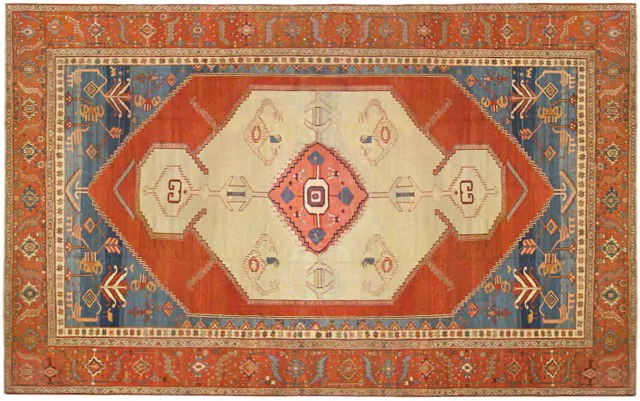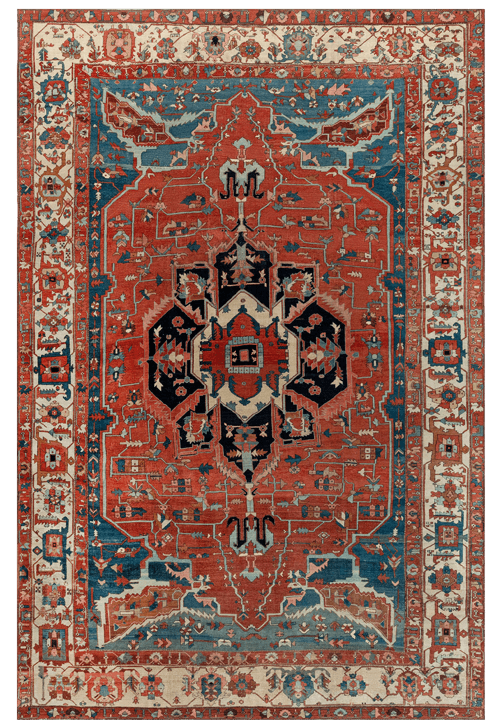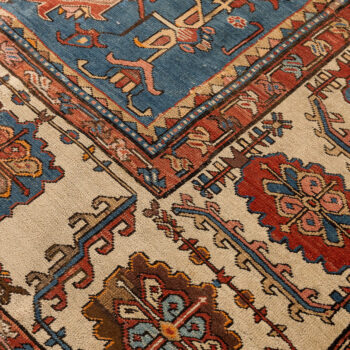Bakhshaish

Within the Heriz group of rugs, Serapi and Bakshaish rugs are produced in northern Persia. But, not all Bakshaishs are great; there are smaller pieces. But those that are larger appear to be one of the few large rug productions that have managed to overcome the usual aesthetic divide between tribal and large Uban rug weaving. There is no Bakshaish standard. Bakshaishes are made with designs that cover the entire area of the rug as well as medallion-type compositions.
They can have floral or geometric designs or something in between. But what distinguishes a Bakshaish is its bold and expressive design. It could be called expressionist. It has the same graphic quality that you look for in a great Kazak or an excellent Turkish rug. And like these, Bakshaishes can present abrupt or radical visual effects.
Both repeating motifs and medallions can change their shape, scale or proportion. The spacing of the motifs and even the central medallions can be improvised. The design is large-scale and graphic, and often highly geometricized, even when applied to a demonstrably urban prototype or model. The corners of the carpets are also often improvised. Simply put, the Bakshaish is a large village rug, and for enthusiasts of village production, the Bakshaish represents one of the few options for a larger rug.


It is surprising that the origins of Bakshaish rug production are still not entirely clear. It would be wonderful if we could isolate or identify the earlier traditions of Bakshaish artists to understand how they transferred a village aesthetic to the production of larger pieces.
One hypothesis is that these artists who traditionally produced tribal or smaller village products were at some point induced to enter into the production of large-sized pieces to meet the demand of foreign markets. This involved a reorganization of production methods, as more people and greater investment are needed to produce larger rugs. Perhaps entire villages or extended families collaborated to produce larger Bakshaish rugs. But what is striking is that such changes did not affect the creative or technical processes, which still favored improvisation and spontaneity, although several weavers were involved in an organized and disciplined effort.
This is where the appeal of Bakshaishes artists lies. They have never lost their distinct creativeness and peculiarity even in the midst of meeting market demands. They are the only room-sized rugs that convey the artist’s emotive power like the best rugs from smaller villages. It’s this rare achievement that still makes them so prized among rug lovers, and rightly so.
Decorating with an antique Bakshaish rug from Persia
The variety of design styles across the incredibly wide spectrum of Persian rugs is remarkable. There are those antique rug styles that are more tribal and less formally composed on one end, and styles that are more stark, classic and geometric on the other. While some people will always gravitate toward one end of this spectrum, others will naturally gravitate toward the other end.
But what about those people who prefer something in between? Say, something with traditional tribal elements, but perhaps also with some kind of underlying structure and composition? This is where ancient Bakshaish rugs, historically produced in northern Persia, come into play.
When decorating with an antique Bakshaish rug, it is important to first note that generally Bakshaish rugs that straddle the usual aesthetic divide between village or tribal designs and more classic designs are, conventionally, larger pieces.
It is also important to note that there is in fact no consistent “Bakshaish standard”. Bakshaish rugs can be found with designs that cover the entire rug or with medallions or both. In fact, the only quality that can be found in the Bakshaish style is a distinct, bold quality that appears characteristically abstract.
The rug below presents an example of a solidly composed antique Bakshaish rug that still manages to articulate its quality of tribal authenticity, bringing together what are often disparate design elements into a beautiful, harmonious piece.

Figalli Oriental Rugs
We do not sell rugs. We bring rare works of art to your home in the form of rugs.
Our services
You are Protected
Copyright © 2023 Figalli Oriental Rugs, All rights reserved. Desenvolvido por Agência DLB – Agência de Marketing Digital em Porto Alegre


